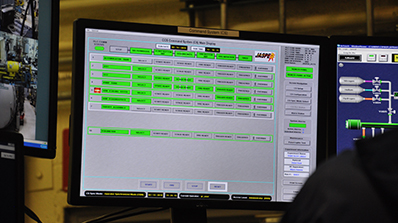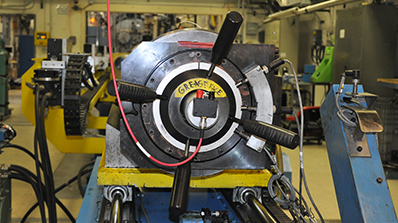The team at the Joint Actinide Shock Physics Experimental Research (JASPER) facility at the Nevada National Security Site (NNSS) is proud to have recently conducted a two-stage experiment: validating the new flash X-ray (FXR) with the NNSS-designed continuous X-ray (CXR), to ensure they will function properly for future experiments supporting stockpile certification.
In partnership with Lawrence Livermore National Laboratory (LLNL), the JASPER team, led by NNSS Principal Project Manager Mark Hansen, installed a new CXR system in October and the new FXR system in November, then conducted tests in December. After perfecting scientific techniques, the January experiment proved to be a success.
“Our own NNSS people developed the upgraded CXR system at the North Las Vegas Facility,” Hansen said. “We did the initial testing and development there, then installed it here at JASPER. While used with the FXR, our old CXR system was becoming unreliable, which affects our velocity measurements. The new system provides easier maintenance with quicker rebuilds. The new upgraded system also simplifies our process for the experiments.”

The FXR is an imaging system used to measure velocity of the projectile on a JASPER experiment.
“To do this, we’re taking pictures of the projectile at two different locations to measure velocity, which delivers an accuracy of 99.9 percent,” Hansen said. “The FXR provides accurate velocity measurements that assist in the experimental data, which validates the weapons in our stockpile.”
The FXR works together with the CXR, a prompt trigger for the experiments. It’s the first trigger the projectile sees that initiates the start time of all diagnostics (similar to a start button on a camera), and looks at all the signals as the projectile travels toward the target. It also starts the clock to close the ultra-fast closure valve, which is used for containment. This is the critical part of the CXR, ensuring closure for complete containment within the primary target chamber.
Hansen mentioned that the Nevada Operations Group did a market study and found a CXR system to meet JASPER’s needs.
“The new CXR system’s communications was developed in-house,” he said. “We did the initial testing and development on it in North Las Vegas.”

Hansen added that our LLNL customer is pleased with the performance of the new CXR system.
“With the old system, it took us over an hour to bring it up initially. The new CXR only takes two minutes. This obviously cuts a lot of time out of the process.” This was particularly demonstrated in March when JASPER conducted its 10th experiment over a nine-week period. “This is a significant uptick in frequency,” he said.
See more about the JASPER facility in this video.

